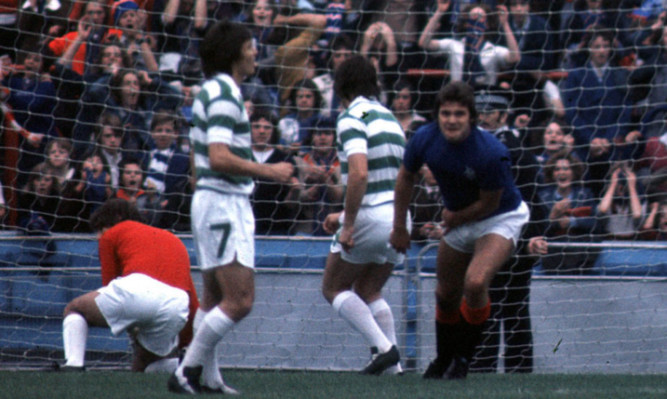
DEREK JOHNSTONE’S second exit from Ibrox, back in the summer of 1986, pretty much saw him pass England skipper Terry Butcher on his way in the front door.
The Graeme Souness revolution was under way and the man leading the charge had no use for an injury-troubled 32-year-old.
Not even when that 32-year-old was a Light Blues legend, who could boast 350 appearances and 131 goals from his first spell at the club.
Some three decades on, Johnstone, now a media pundit, sees distinct similarities with current events.
For Souness read Mark Warburton, for Butcher substitute Danny Wilson, the former Hearts skipper and Scotland internationalist.
And if there isn’t a veteran striker heading in the opposite direction just yet, Johnstone reckons that could be just a matter of time as the new boss looks to bring in a young forward to lead the line.
“I wouldn’t be looking for Danny to make the impact Big Terry did because that would not be fair,” said DJ.
“Those were exceptional times back then and to go out and get the captain of England was remarkable, even by Graeme’s standards.
“But I do believe we can see the same logic at work.
“New managers almost always want to sort things out and they always start out with the defence.
“And if they can bring in a player who personifies the type of football they want to play, then that is a huge plus.
“That is what Rangers and Mark who strikes me as a bright, innovative modern manager are getting with Danny.
“He is a centre-half who is happy collecting the ball from the goalkeeper and playing it out.
“As we know from watching him in his first spell at Ibrox and from his time at Hearts last season, Danny’s a tremendous passer of the ball.
“You watch him hit cross-field passes to team-mates and you are reminded of Charlie Adam. He has that kind of ability.
“But the best thing about him is he is a proper defender. He is 6ft 2in tall and really good in the air.
“Play him alongside Rob Kiernan, who is 6ft 3in and jumps well too, and Rangers should not have any aerial problems this season.
“And there you have an improvement straight away.
“Danny is also very good on the ground. He is quick and reads the game well.
“Plus, and this is very important when you are talking about Rangers, he is very calm and composed in the way he goes about his business.
“That was the way he played when he was 17 years old and making his breakthrough in his first spell alongside Davie Weir.
“He played a couple of Champions League games back then and neither the size of the crowd, nor the importance of the occasion, fazed him then. So I don’t see any reason why they will now.”
Johnstone’s last comment is significant as the old football saying; “Never go back” has a grounding in fact.
Colin Stein, Gordon Smith, Johnstone himself and others all returned to Ibrox yet failed to match the heights set in their first spells with the Govan club.
Kris Boyd, who has departed the club in the opening scenario, is another more modern example.
“To be fair to Danny, I think the circumstances are different in his case compared to the rest of us,” said Johnstone.
“He is a young lad, still only 23 years old, where all of us came back later in our careers.
“And his first stint was a short one in terms of the first team anyway because, of course, he did come through the youth system.
“That’s not what I did. The majority of my career was spent at Ibrox and I left because I had not been playing much latterly under John Greig, who was manager at the time.
“The move to Chelsea wasn’t the best for me but I left the right way, thanking everybody for the time I’d had with Rangers.
“As the records show, I struggled to make an impact at Stamford Bridge, what with injuries and the rest, so I was delighted when big Jock Wallace (right) gave me the chance to go back up the road at the start of 1985.
“I found out then what so many others have, that it can indeed be tough to go back late in your career.
“Everyone expects you to be the player they remember from five, six years ago and you just aren’t.
“You get slower not that I was ever that fast in the first place and you are not able to do the things you once could.
“And for a lot of us as well, injuries take their toll. You put a lot of strain on your body playing professional sport and it isn’t always possible to bounce straight back.
“Listen, though, the fans were brilliant with me. They appreciated I had done a turn for the club and never forgot that.
“I am sure Gordon Smith and Colin Stein would say exactly the same thing.
“Yes, Danny left for Liverpool without putting in a lot of years, but the game has moved on from my time and it would have had been a very hard opportunity for him and his family to turn down.
“Now, a couple of years on, they have turned down chances to go elsewhere to come back to Glasgow. I am sure 99.9% of Rangers supporters will welcome his return and the decision to sign him.”

Enjoy the convenience of having The Sunday Post delivered as a digital ePaper straight to your smartphone, tablet or computer.
Subscribe for only £5.49 a month and enjoy all the benefits of the printed paper as a digital replica.
Subscribe